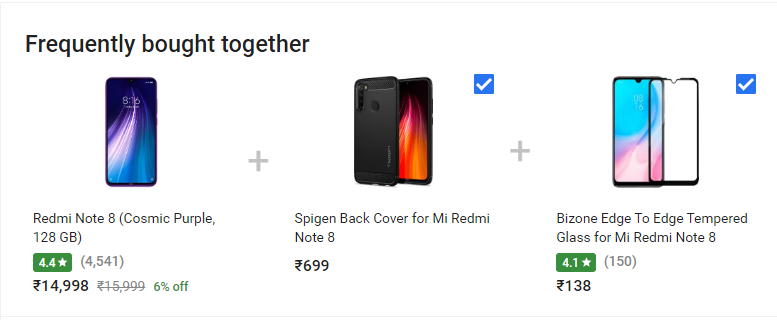E-commerce Product Recommendations: Best Practices &Tips
Blog: MattsenKumar Blog
An Adobe study found “returning customers spend three times more than the first-timers” and the study also revealed, “€5.34 is the average amount spent by a repeat customer in comparison to €1.75 spent by first-timers”.
The study also adds a new dimension to the customer acquisition vs customer retention debate – Product Recommendations. The ever-increasing cost of customer acquisition and dipping customer lifetime value (CLV) is coaxing organizations to discover alternative routes for growth. Product recommendations are perhaps the way forward for e-commerce success. Amazon leveraged the power of e-commerce analytics and used it to recommend relevant products and registered a gain of 29% in revenue. Amazon’s revenue increased from $9.9 billion to $12.83 billion for the 2nd quarter of 2019 in comparison to the previous year.
Data-driven marketing has found a new admirer in the e-commerce industry. Organizations are now relying heavily on data created by the user to decipher patterns and recommend relevant products. Since big e-commerce players have a million users (touchpoints) to test, it is easier to find what works and what doesn’t, almost instantly. The best example of this is how Amazon has aced both in on-site as well as other digital recommendations.
What are the benefits of E-commerce Product Recommendations?
Anyone who says artificial intelligence and machine learning is expensive tools should pay attention to the cost of ignorance. Dipping customer experience can render businesses obsolete. With big entities like Amazon are enhancing the experience with state-of-the-art technologies, other nascent players have no choice but to follow suit.
To help emerging players understand why investing in product recommendation is indispensable, here are some statistics to prove the point:
- A Salesforce study revealed, “product recommendations account only 7% of e-commerce traffic but make up for 24% of orders and 26% of revenue”,
- Independent research by Barilliance concludes “customers found 12% of their orders belong to products recommended to them”,
- An Accenture report suggests “personalized recommendations increase chances of conversion by 75%”.
Also Read: E-commerce Fraud Prevention- 6 Common Types & Necessary Precautions
Best Practice for E-commerce Product Recommendations
1. Recommended For You
Perhaps the most common and impactful way of recommending products. E-commerce stores use “recommended for you” with the name of customers to impart a more personalized experience.
“Recommended for you” tab is often based on the browsing history of a customer and serves a great purpose for both customers and marketplaces. Customers find recommendations that are either relevant or alternative to the products they recently viewed.
The benefits of recommended for your tab include:
- Helps customer discover new and relevant products,
- Allows customers to compare two or more products and
- Aids in enhancing the customer’s experience via personalization.
 Source: Amazon
Source: Amazon
2. Frequently Bought Together
Such recommendations work best with high-value products. Since people tend to buy covers with the phone, listing covers under the “frequently bought together” provides an incomparable up-selling opportunity. Such tabs not only improves the overall customer experience by simplifying searches but also impacts CLV.
Tip: Sometimes, a customer might be in hurry and fail to look at the “frequently bought together” tab placed just below the item hence listing it on the “order details” page, which appears after an order is placed can help drive more sales.
Example: A customer who bought Kindle from Amazon will need a cover and displaying covers for the same model bought can improve the chances of up-selling.

Source: Flipkart
Must Read: E-commerce Catalog Improvements – 8 Tips to Boost the Performance
3. Related To Items You Have Viewed
Customers often do not know the right keyword and search for products in their local language, which bears no result. By leveraging the power of e-commerce analytics, online stores can generate a set of recommendations and display it under the title “related to items you have viewed” and help customers find relevant products faster.
Such tabs also encourage customers to add additional products to the cart making up for a classic case of cross-selling.
Source: Myntra
4. Customers Who Bought This Item Also Bought
E-commerce platforms are now emerging as the preferred platform for product discovery. The smart use of artificial intelligence to improve on-site search has helped online stores impart a quality customer experience. Improved customer experience inspires users to spend a lot of time looking for new but relevant products.
Data generated by users when leveraged to recommend products has helped e-commerce stores immensely. This can be further leveraged with the use of tabs like “customers who bought this item also bought”.
Example: “customers who bought this item also bought” to customers who buy hair wig is a great way of driving sales. Since a person who buys hair patch online will need to buy hair glue and c20 solvent, showing them in recommendation can benefit both, the customer as well as the online store.

Source: Amazon
Also Read: 7 Pain Points Sellers Face on E-commerce Marketplaces & Solutions
5.Bestselling In Particular Categories
While e-commerce stores have enabled people with the option to shop from anywhere, anytime, it is yet to educate them about varied brands and versions of a product. Customers often end up buying median products even when quality products are available at the same price just because they lack information. Mostly these products are later returned because customers find out about the better products from their friends/families or online research.
E-commerce stores can educate customers about the best product with tabs like “bestselling in particular categories”. Such recommendations will help customers find and order only quality products, which will bring them back again and again. With these recommendations, online stores can also control increasing return rates.

Source: Amazon
6. There Is A Newer Version Of This Item
Customers often bookmark products to buy them on special occasions like birthdays, anniversaries and festivals. It so happens that by the time the customer tries to buy it, the product is out of stock or a better version is available.
By recommending the latest version or model of the product through tabs like “there is a newer version of this item”, here’s how online stores can benefit:
- Reduce the chances of old product getting returned
- Improve the overall popularity of the new product
- Enhance customer experience by a notch and
- Up-sell a new product
Must Read: Seller Management: Best Practices for Online Marketplaces
7. The Off-site Recommendations Via Email
Varied independent studies have shown that off-site recommendations are more effective than on-site recommendations. E-commerce organizations can leverage the potential of email marketing to receive more orders.
Putting remarketing in sync with e-commerce analytics can help online stores save heavily on customer acquisition and retention. By considering email recommendation as a mainstream tool, online stores can generate huge revenue.

Source: Recommendation via email
Conclusion
With the emergence of new players with impactful patented technologies, existing players need to devise their strategy. Becoming more customer-centric can help big players retain their position. Leverage the latest technologies like machine learning to dig deeper into the data created by users for predicting their next move and you will become the next Amazon.
By leveraging e-commerce product recommendations to increase revenue from $9.9 billion to $12.9 in just one quarter, Amazon has shown other players the way. It is about time that other players implemented such recommendation tabs and receive more orders.
The post E-commerce Product Recommendations: Best Practices &Tips appeared first on MattsenKumar.
Leave a Comment
You must be logged in to post a comment.








